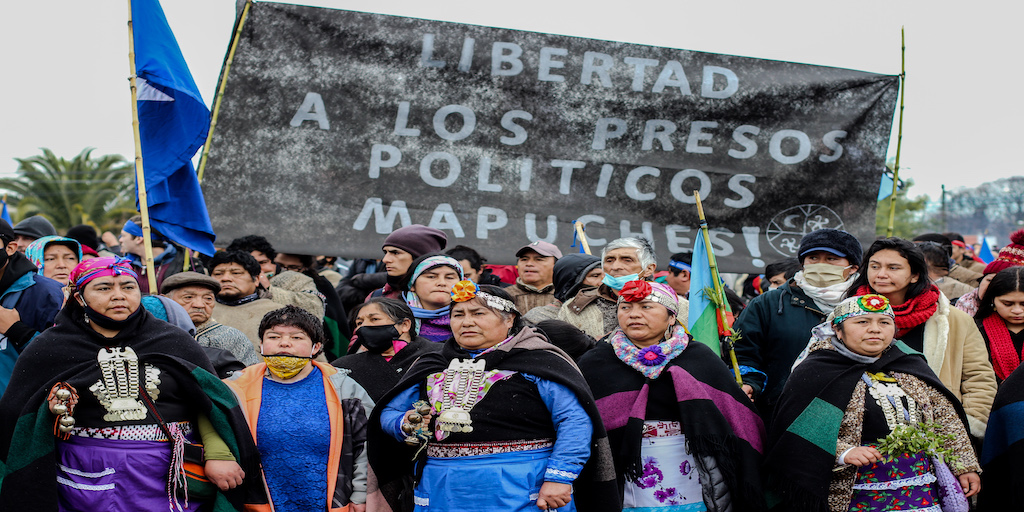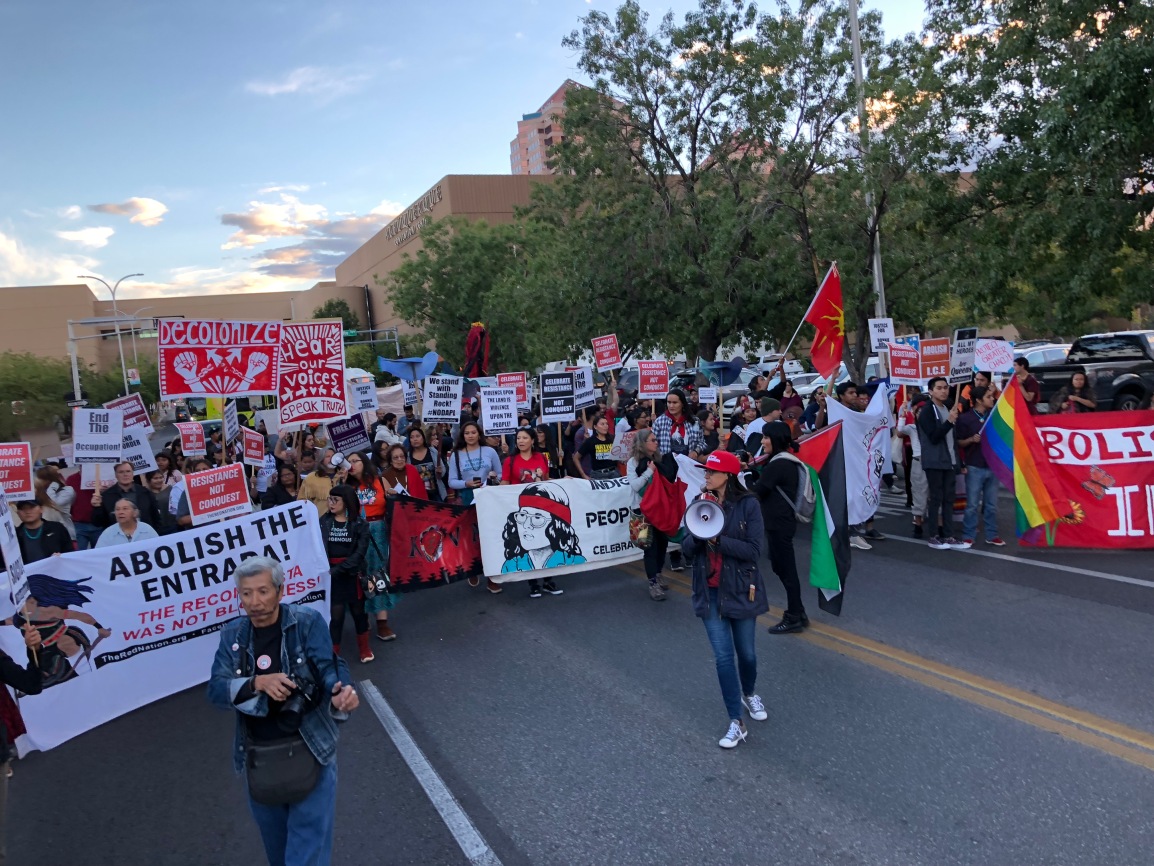
November 5, 2018
Dear friends,
Greetings from The Red Nation. This being our first newsletter, we have many stories and events to cover.
In June 1974, on the final day of the first International Indian Treaty Council meeting at the Standing Rock Indian Reservation, the mood was serious. A colossal task lay before the Red Nations of the Americas. Counterrevolution was rearing its ugly head. American Indian Movement (AIM) leaders had been tied up in the courts after the armed-takeover of Wounded Knee in 1973. The FBI’s notorious COINTELPRO program had infiltrated the organization, nearly crushing the Indigenous movement in the United States.
The violent crackdowns didn’t deter what was an historic moment. The Lakota and Dakota elders who had asked them to take a stand at Wounded Knee now asked the warriors—the men, women, and children of Red Power—to take their struggle to the United Nations and to the world. Sensing the gravity of the situation, Oglala AIM leader Russell Means took the microphone. “What we are into is revolution, turning that cycle of life always back,” he told the crowd. The next step was onto a world stage.
Going to the UN and aligning with struggles throughout the world saved the Indigenous movement from collapse. The International Indian Treaty Council spent four decades working with peoples from all continents. The 2007 United Nations Declaration of the Rights of Indigenous Peoples, a touchstone document, was the fruit of their labor and their sacrifice. The evidence of that international work was visible at the 2016-2017 Standing Rock protests against the Dakota Access Pipeline, where allied struggles from around the world showed up to defend Indigenous treaty rights and water.
That spirit of solidarity lives on in the celebrations of Indigenous Peoples Day, not just in words but in deeds. For example, I wrote three years ago when Albuquerque, New Mexico celebrated its first Indigenous Peoples Day:
In 1977, the International Indian Treaty Council… called for the end of the celebration of Columbus Day and declared instead the International Day of Solidarity and Mourning with Indigenous Peoples. The UN Committee on Racism, Racial Discrimination, Apartheid, and Colonialism passed the resolution, with the support of many organizations, such as the African National Congress and the Palestine Liberation Organization, who recognized that the devastating legacies of European colonialism and African slavery had to be addressed in the Americas. In 1982, Spain and the Vatican proposed a 500-year commemoration of Columbus’s voyage at the UN General Assembly. The entire African delegation, in solidarity with Indigenous peoples of the Americas, walked out of the meeting in protest of celebrating colonialism—the very system the UN was supposed to end. The commemoration was crushed, and the UN declared a celebration of the World’s Indigenous Peoples Day and the Decade for the World’s Indigenous Peoples, which began in 1994. The second Decade was declared in 2005.
Our sacred duty today is to remember the history and to caretake the tradition, not simply by decree but by action. Last month, hundreds took the streets of Albuquerque for the third annual Indigenous Peoples Day. Dozens of cities have passed Indigenous Peoples Day resolutions to replace Columbus Day, every second Monday of October. This year, The Red Nation gave special salutes to the struggles of Palestinians and our relatives targeted by La Migra.
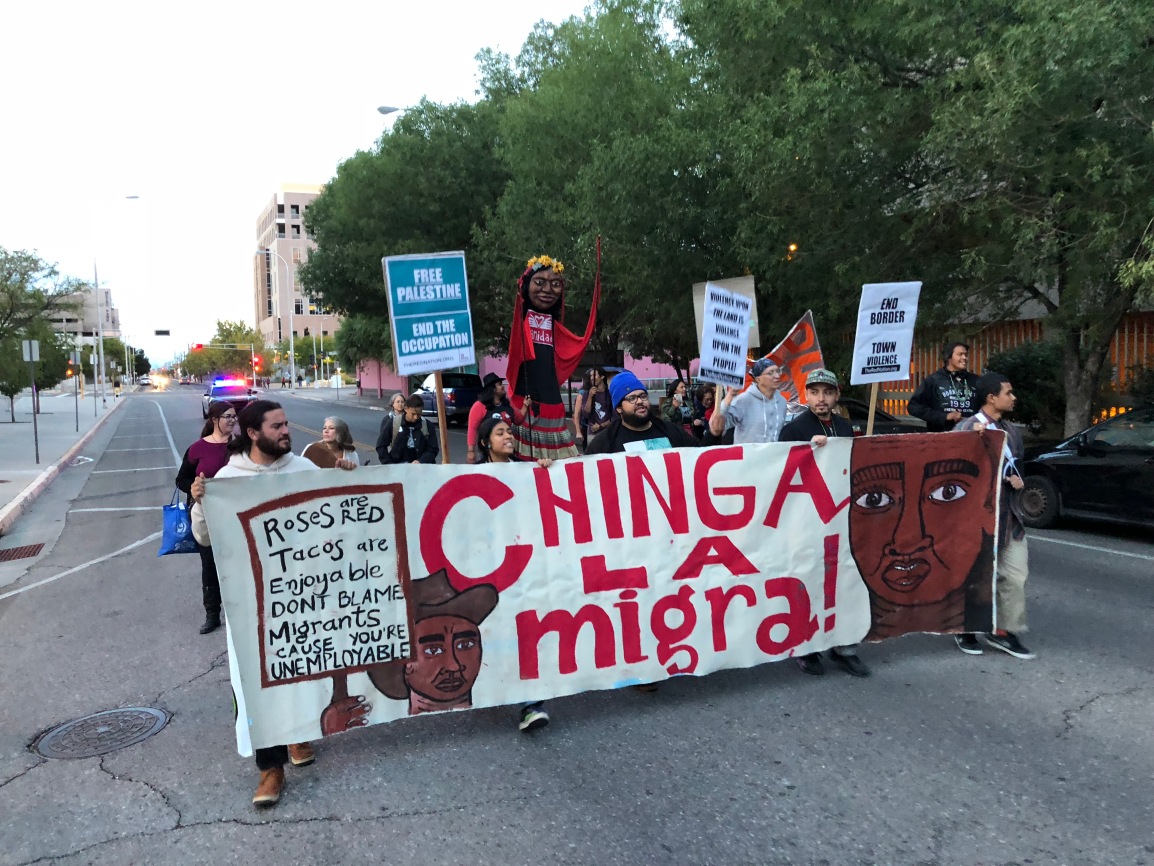
People around the world are marching towards justice, and they are met with the cold steel of rifles and the bars of cages. Heartlessness describes our times.
Since March, nearly two hundred Palestinians in Gaza have been killed marching towards the Israeli perimeter fence. Israeli snipers have not spared children, women, the elderly, nurses, journalists, or aid workers. Despite a ceasefire, Israel continued killing children. The Great March of Return comes fifty years after the Nakba. Since the creation of the state of Israel, millions of Palestinians have been violently displaced, and their lands seized and resettled.
The routine violence against Palestinians, Nadya Raja and Omar Zahzah write, aims “to cook the Indigenous out of the people.” Nadya and Omar are friends of The Red Nation and organizers with the Palestine Youth Movement, who recently contributed an essay to a special issue of The Funambulist Magazine on settler colonialism in Turtle Island, which was co-edited by myself and Melanie Yazzie, the current Chair of The Red Nation. The issue examines several facets of Indigenous struggles in Turtle Island. Most of them depict Native lives in spaces that are not the reservations where the colonial narrative usually situates them. Whether in large cities such as Los Angeles (Desiree Martinez, Cindi Alvitre, and Mishuana Goeman) or Saskatoon (Jaskiran Dhillon) or settler border towns in the periphery of reservations (Melanie K. Yazzie, Nick Estes, Jennifer Nez Denetdale, Joel Waters) the urban dimension of the first half of the dossier is omnipresent. In the second half is dedicated to various forms of Indigenous resistance through space-making (Nick Estes), anti-colonial solidarities (Palestinian Youth Movement), representative transgression (Leya Tess), or architecture projects (Elsa Hoover, Geraldene Blackgoat, David Eslahi).
The story is the same wherever there are borders to punish the poor. U.S. President Trump recently gnashed his teeth at the Honduran refugees approaching the U.S. from Mexico. (Zoe PC wrote an excellent report on this here.) What awaits the refugees when they arrive is uncertain. What is certain is that thousands of migrant children still remain in cages, and Trump has deployed thousands of U.S. soldiers to the U.S.-Mexico border to greet more migrants not with humanity but with violence.
Racism always masks the real threat. While brown migrants (many of them Indigenous) are made into “criminals,” white settlers still commit horrific acts of violence, emboldened by the words and actions of Trump and his ilk. Recently, a racist slaughtered 11 Jewish people at a Pittsburgh Synagogue while shouting anti-Semitic slogans, and another gunned down two Black people in a grocery store while shouting anti-Black slurs.
The only cure for murderous racism is solidarity. But solidarity is anathema in our current system. That is why we have build a new one by tearing down the old one. It begins by rejecting the alienation that we experience and the individualism that is rewarded under capitalism. In our work, we emphasize forming new communities grounded in Indigenous notions of mutual aid and kinship that goes beyond imperial borders.
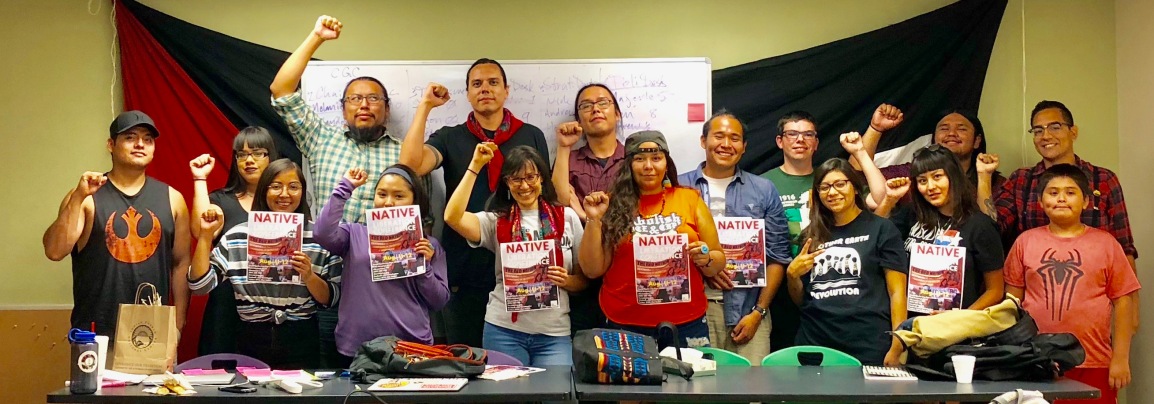
In August, the third annual Native Liberation Conference, held in Albuquerque, drew more than 300 participants. International delegations came from Mexico and Palestine, and dozens of Indigenous nations and allied organizations from around the world were represented. This year, our General Assembly drafted and adopted our governing documents, elected leadership, and expanded our membership. We selected Gallup, New Mexico as our next conference site for 2019.
We applaud the recent formation of our sister branch the Santa Fe Freedom Council and the one-year of anniversary of the formation of our other sister branch the Gallup Freedom Council. Our comrades and relatives in Gallup wrote this beautiful report of their one year in struggle, from revolutionary drag shows to helping feed and cloth children and our relatives on the street.
We build Indigenous peoples power to turn back the forces of destruction. Here, in New Mexico, both Democrats and Republicans have allied with the oil and gas industry against Indigenous communities. Voting only solves part of the problem by ousting the lesser-of-two-evils. But the other evil remains, and its poisoning our lands and our world.
The Intergovernmental Panel on Climate Change issued a dire warning last month: there is no safe level of global warming, and to stave off the most deleterious effects of climate change, nations have only twelve years to transition out of a carbon economy. Those measures should have been taken yesterday. But today the alarm bells are not ringing. Climate change was not on the ballots in the U.S. midterms. In fact, it’s largely ignored by the corporate media’s election coverage. Not to mention the main driver of global warming and environmental destruction, capitalism, is never mentioned and neither is its alternative, revolution, as the only means to save the planet.
While the world the burns, the world’s billionaires got 20 percent richer in 2017. And while corporate politicians line their pockets with dirty oil and gas money, Indigenous peoples in the Southwest are fighting back because it is their lands, waters, and lives that have always been sacrificed on the mantle of profit. No one can save us but ourselves.
In Dinetah (the Navajo Nation) and the Greater Chaco Landscape, part of which is a UNESCO World Heritage Site, ordinary people are not waiting for permission. They’re taking action against the fracking industries destroying their lands, waters, and sacred sites. Last March, a group of young Diné and Pueblo femmes from organizations such as The Red Nation and Pueblo Action Alliance successfully halted the leasing of sacred lands for oil and gas exploration. Thousands of acres were temporarily saved—an historic victory by humble people.
Last Wednesday, the Frack Off Greater Chaco Coalition hand-delivered more than 10,000 individual letters protesting further oil and gas leasing to the Bureau of Land Management office in Santa Fe. (Read the Wild Earth Guardians’ report here.) It was the most protest letters ever delivered in New Mexico’s history. Mario Atencio from Diné CARE denounced the proposed leasing as “modern day energy colonialism.” “The BLM and all other arms of the U.S. settler state—whose very existence depends upon the continued theft and exploitation of Indigenous land,” Melanie Yazzie from The Red Nation told the crowd, “have an obligation to heed the demands of Indigenous peoples to #FrackOff our lands and waters. If they do not, this opposition will continue to grow until our demands are met.” (Check out the dates of upcoming anti-fracking actions at the end of this newsletter. We need volunteers, especially to protest the upcoming December 5 BLM lease sales.)
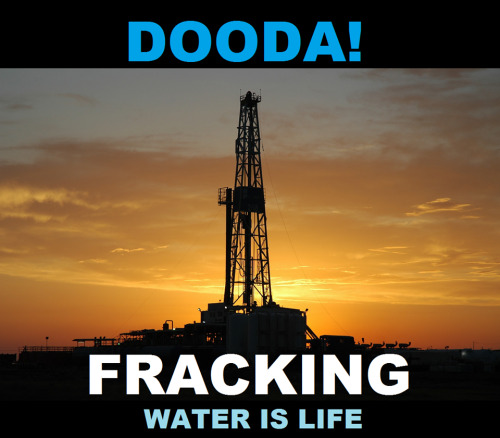
The wounded giants of industry have since recoiled, plotting their counterattack. Like vampires, they thirst for not only oil and gas, but water—the lifeblood of Indigenous communities in the high desert. Our comrade Berkley Carnine recently uncovered a sinister billion dollar backroom deal between state officials and the oil and gas industry to dump dirty frack water (what industry politely calls “produced water”) into precious freshwater aquifers and rivers. The process will relieve industry of the cleanup costs by placing the financial and environmental burden onto the public and Indigenous communities. They are not dumping frack water in midtown Manhattan. They are dumping it in poor, racialized, and rural communities. What’s even more frightening is the nuclear waste slated to be stored in Los Alamos facilities where seismic activity has increased due to fracking. No studies have been conducted to determine the safety of storing nuclear waste in areas with increased earthquake activity.
These environmental catastrophes have happened and have been accelerated under both Democratic and Republican leadership, often with both parties working together to profit from our demise. We cannot vote our way out of climate change or the ruins of the present. We cannot vote humanity back into a system if it was never there to begin with. What we are into is revolution, to turn back the forces of destruction. While this midterm is an important one, we know that voting is only one tool in our toolbox.
November is Native American Heritage Month. But it is also month of critical reflection. The Red Nation is planning a “No Thanks, No Giving November” two-day event to honor the real history of Thanksgiving, which entailed Native genocide and the plunder of an entire continent, and to provide ethical alternatives by coming together as community. Mark your calendars for Thursday, November 22 and Friday, November 23 at the Sundowner Community Room at NewLife Homes, 6101 Central Ave NE, Albuquerque. We invite you to an anti-colonial community potluck on Thursday evening from 5-9 PM. We will share food and host a teach-in on the history of Thanksgiving. On Friday afternoon from 12-5 PM we will be hosting a “Red Friday” event and collecting donations and winter gear for our relatives on the streets. Stop by to also catch workshops and teach-ins on anti-capitalism and fighting fracking in the Greater Chaco Landscape.
The holiday season can be a difficult time for some. And given the times we live in, we hope you don’t struggle alone. I recently wrote an online letter of encouragement to those facing loneliness in this time of terrible danger. This is how I see the work of The Red Nation:
We’re not paid activists. We don’t get grants. We don’t have a board of directors. We don’t have [Annual Performance Reviews] or funders to answer to. We democratically elect leadership and hold each other accountable. We’re volunteers. We’re only accountable to each other and our own nations. We create our own resources. We self-produce our spaces, knowledges, and campaigns. We train and teach each other and co-create kinship and relations. We socially and collectively own the work and are 100% independent of corporate and colonial state funding.
We’re also not all “frontline warriors.” Some of us are low-key radicals who do work for the group that is just as important as direct actions, like doing outreach, writing articles, making banners and posters, administering the organization, archiving, childcare, making food and coffee, working with our relatives on the streets, or just providing emotional support for folks. It’s all equal and democratic work. (And we’ve each happily done all of it to some degree!) Sometimes providing support for others in these nightmarish times—that is, keeping the flame burning, however small it may seem—is the most important work.
Sometimes, we work behind the scenes to amplify other voices, which are typically marginalized. We’re not here to be *the* group with *the* best graphics and politics. We’re here to win, and to build a revolutionary Indigenous movement.
Be a part of something and struggle together. Build something collectively. Don’t struggle alone. Don’t just be against something, be for building a decolonized future with other rad Indigenous leftists and revolutionaries.
We’re here for you. Join us.
Solidarity forever,
Nick
Editor of The Red Nation
MARK YOUR CALENDARS: Upcoming events and actions. More information to come.
NOVEMBER
11/8: Frack Off Realities Tour: Northern Navajo Nation. Counselor, NM.
11/9-11/10: EPA Symposium Action. Lybrook elementary. Lybrook, NM.
11/13: Red Power Revolution Speaker Series: Janene Yazzie @ 2 PM. SUB Ballroom C. UNM-Albuquerque, NM.
11/15-11/16: New Mexico Produced Water Conference Action. Hotel Santa Fe. Santa Fe, NM.
11/22: No Thanks No Giving Community Forum & Teach-in. Sundowner Community Center. Albuquerque, NM.
11/23: Red Friday Winter Drive & Workshop. Sundowner Community Center. Albuquerque, NM.
11/29: Red Power Revolution Speaker Series: Warrior Women Film Screening @ 5 PM. George Pearl Auditorium. University of New Mexico. Albuquerque, NM.
DECEMBER
12/5: BLM Lease Sale Protest & Action. NM State Office BLM. Santa Fe, NM.
Subscribe: